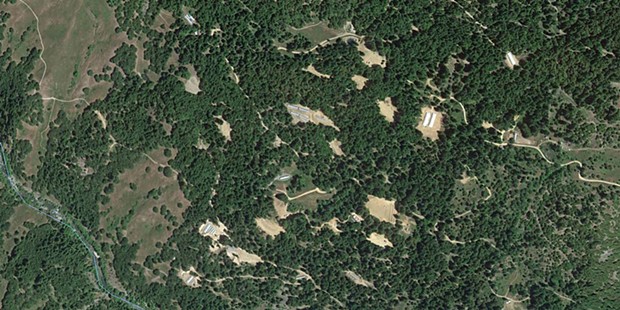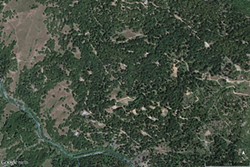The Carrot and the Stick
While urging compliance, county does little to ramp up enforcement
By Thadeus Greenson [email protected] @ThadeusGreenson[
{
"name": "Top Stories Video Pair",
"insertPoint": "7",
"component": "17087298",
"parentWrapperClass": "fdn-ads-inline-content-block",
"requiredCountToDisplay": "1"
}
]
By law enforcement estimates, there are about 10,000 marijuana farms in Humboldt County. About 2,300 of them have applied for the county permits needed to legitimize under local and state laws. Of those, about 400 have gone through the required permitting process by the California Department of Fish and Wildlife. Of those, about 200 are already back out of compliance.
For all the talk of legalization, regulation and progress, Humboldt County has a whole lot of work to do.
Humboldt County Planning Director John H. Ford said the county received a total of 2,337 cannabis cultivation permit applications, about 90 percent of which are incomplete and a large number of which are "grossly incomplete." Those that are incomplete have been notified by letter and told what's missing. Ford said the county has two teams of planners — including some extra help — and is working on processing applications as quickly as it can. Applicants who have made no headway on their applications for six months will receive a 30-day notice, he said, after which the applications will be voided.
"But if we see that people are making an effort to get a complete application, we're going to work with them," Ford said. "The numbers are crazy. Two-thousand-three-hundred — that's a daunting number."
They aren't seeing anything like that number over at the Department of Fish and Wildlife, environmental scientist Scott Bauer said. "We've permitted about 400 sites since 2015," he said. "And we're receiving calls daily from people wanting us to go look at their sites."
Bauer said the permitting is a labor intensive process, as every site is different. So the application process necessitates site visits to look at water storage, grading, roads and culverts in an effort to make sure any adverse impacts to wildlife will be mitigated. And often, Bauer said, the permit process includes a site improvement plan, under which a farm will pledge to re-grade a road, widen a culvert or increase water storage capacity in future years. The permits often require monitoring reports and status updates, which is where about half of all permits have landed out of compliance, he said.
The department is trying to be flexible and pragmatic, Bauer said, with full knowledge that an underground industry can't come into compliance over night. But you can also hear frustration in Bauer's voice.
"At some point, you've got to accept responsibility," he said. "And that means getting your permits and changing your practices to reduce your impacts to the environment to be less than significant."
The host of agencies involved in permitting these cannabis cultivation operations are pledging to exercise patience to those coming into the system, but what about the other 7,500 or so growers who seemingly have passed on the opportunity to legitimize? The plain answer is there doesn't seem to be much of a stick awaiting them.
Humboldt County Sheriff Mike Downey has said in the past that his department only has the resources to go after a few dozen large-scale marijuana grows a year and, with legalization passing, it seems marijuana enforcement is shifting from a law enforcement issue to more of a regulatory one.
And enforcement is an issue that has been largely absent from community discussions about how to spend local tax revenue from measures Z and S.
Currently, the county's code enforcement unit has two investigators, support staff and an attorney, according to County Counsel Jeff Blanck. And the unit handles everything from complaints of unpermitted cannabis farms to junk cars and building code violations. "They are very busy," he said flatly. "And what's potentially facing us now is much larger."
Blanck said that if his department starts getting significantly more marijuana related calls he'd approach the board about increasing funding so he can hire another officer. But in the meantime, he said his unit will just "try to keep up with whatever's generated."
And the water board and Fish and Wildlife will keep up their enforcement efforts as well. When it comes to Fish and Wildlife, Bauer said wardens are focusing efforts on watersheds with threatened or endangered species, particularly the South Fork of the Eel River and the Sprowel Creek area. But resources are scarce and it's hard to keep up.
"All agencies that have skin in this game with laws that need enforcement should enforce them," Bauer said. "I think that's important and I think that would also encourage compliance. You have to have both the carrot and the stick. At some point, laws have to be enforced."
Thadeus Greenson is the news editor at the Journal. Reach him at 442-1400, extension 321, or [email protected]. Follow him on Twitter @thadeusgreenson.
To continue the story, please click below to "Culture Change".
Speaking of...
more from the author
Latest in News
Readers also liked…
-
Through Mark Larson's Lens
A local photographer's favorite images of 2022 in Humboldt
- Jan 5, 2023
-
'To Celebrate Our Sovereignty'
Yurok Tribe to host gathering honoring 'ultimate river warrior' on the anniversary of the U.S. Supreme Court ruling that changed everything
- Jun 8, 2023







































